Julia Lawton is ATD’s director of program administration. She leads cross-functional efforts to align and continuously improve ATD’s portfolio of services that support colleges in their pursuit of institutional change, increased student success, and equity. Julia also leads multiple grant-funded projects, most notably ATD’s Prioritizing Adult Community College Enrollment effort (PACCE).
To help familiarize readers with some of the key topics that will inform the Adult Learner Success Summit on May 11, we asked Julia a few questions about her time at ATD and her work with the 20 colleges involved in PACCE.

Q: Tell us about yourself. What first drew you to Achieving the Dream, and what is the “red thread” keeping you connected to the work now?
A: I first heard about Achieving the Dream from a family member who worked at our local community college. I was instantly excited about the potential to be part of a team that could impact communities across the country so when an internship opportunity came up, I applied immediately. I was only a few years out of college where I studied economics, so initially it was the use of data to guide decision-making that spoke to me.
Over nine years later and I still love working here. I’ve had the opportunity to learn from some amazing colleagues and deepen my own knowledge so I can share with others. Ultimately, it’s the focus on equity that keeps me engaged and excited day-to-day. Being a part of an organization that is working to be explicit and intentional about closing equity gaps is both a challenge and a reward.
Q: Tell us about Prioritizing Adult Community College Enrollment (PACCE), a project you lead at ATD. Why is supporting adult learners an important issue for ATD and its partners?
A: Despite the average age of community college students being 28, college’s structures, processes, and cultures are often designed based on the learning and support needs of the traditional 18- to 21-year-old student. This can result in adult learners taking longer to complete their credential, stopping or dropping out, or not getting connected to their local college at all.
PACCE is an intentional effort to scale strategies to connect more adults to the opportunities that a college credential can offer them. Through PACCE, we are working with 20 colleges to scale existing strategies that have proven to increase adult learner enrollment in programs leading to a high-value credential. The colleges are all working on different strategies — some are focused on marketing, others are redesigning their websites, some are expanding partnerships to enroll learners at their partner location, and others are expanding access to online or hybrid learning options.
Q: Since the initiative began in fall 2021, what are some of the most surprising or interesting initiatives you have seen implemented as a result of PACCE?
A: There’s some really great, creative work happening across the PACCE institutions. One of our colleges worked with a local judge to set up a small enrollment site in a private room at the court. The judge shares some information on the college with the individuals who come through the court and directs those interested to meet the enrollment team in the private room.
Another college makes monthly presentations at a local family health center to share information about both credit and non-credit opportunities with health center employees. Video reels highlighting the college also play on monitors throughout the facility.
Another college fostered a stronger collaboration between its English language instructors and other content-specific academic departments — namely the business and hospitality departments — to enable English language learners to co-enroll in a certificate program while they learn English.
—
“For a college to truly be designed to serve adult learners, it needs to be an institution-wide commitment.”
—
Q: These colleges serve different communities — they cover eight states and include rural, urban, and suburban areas. Are there any lessons learned from the cohort that all colleges can benefit from, no matter their context?
A: Definitely begin by getting input from adults in your community. The colleges that engaged adults through surveys and/or focus groups found a lot of value from the insights shared. One college serves a community with a high proportion of immigrants and refugees but enrollment is low from that population. Through focus groups, the college found that their assumptions about what was stopping the college from connecting with this population were wrong. The college had assumed there was a level of fear holding new immigrants back from enrolling in college. However, the focus groups showed it was actually that the college could do more to communicate with this community about the range of programs and services they offer.
Another lesson is that for a college to truly be designed to serve adult learners, it needs to be an institution-wide commitment. One department can’t be charged with the task of enrolling more adult learners alone. The most successful colleges have senior leaders fully engaged in their efforts to better serve adult learners. Engaged leadership can help ensure the efforts are fully resourced, can be a source of strength in building new partnerships within the community, and connect the work to the college’s overarching strategy.
Q: What do you hope to see next from community colleges, and from higher education more generally, to support this demographic of learners?
A: I’d like to see more pathways between credit and non-credit programs. Through PACCE, I’ve been able to work with continuing education, credit programs, and workforce reskilling departments, and it’s clear there are some opportunities for improvement to better serve adult learners. Some of the PACCE colleges are working to streamline and align their enrollment and onboarding processes so it’s easier for a student to transition from continuing education to credit programs. As mentioned, another college is exploring ways to increase enrollment of English language learners into credit programs while they finish their English classes. Still others are working on stacking microcredentials into pathways that can lead all the way to an associate degree or beyond. These pathways are critical to effectively serving adult learners.
Q: What do you think your biggest takeaway will be from this initiative? What insights, strategies, or convictions will you bring into your next project at ATD as a result of PACCE?
A: My biggest takeaway is that more community colleges could benefit from developing a strategic enrollment management plan focused on underserved communities of adult learners. Some of the PACCE colleges are taking a nuanced look at the communities they serve and identifying the neighborhoods and demographics that are least connected to the college and building a comprehensive approach to addressing those opportunities. I think this level of understanding of your community is critical to crafting a successful adult learner strategy.
Learn more

Holistic Student Supports

Adult Learner Success Summit
This half day Summit, taking place on May 11 from 11:15 a.m. – 5:00 p.m. ET, will explore the diverse experiences of adult learners (students aged 25+) and share high impact practices colleges can implement to better serve these students. This summit is offered at no cost to ATD Network Colleges.
